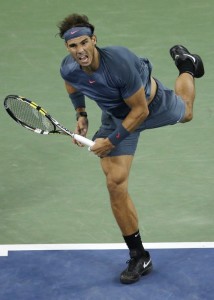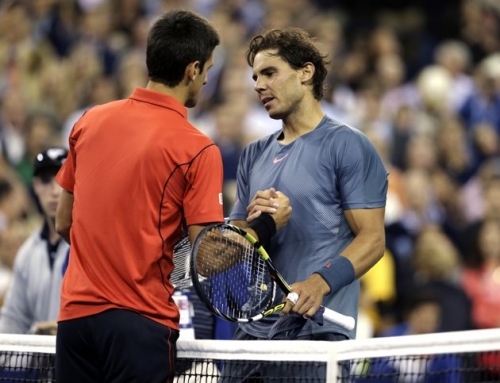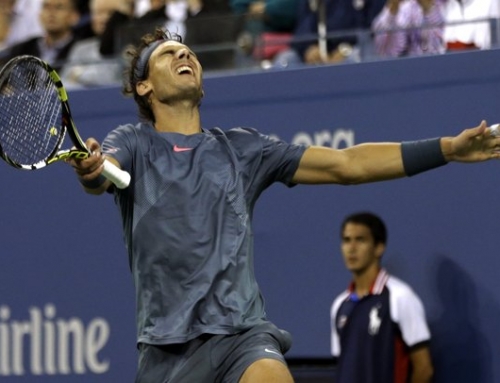 My discussion about Nadal will be mercilessly short, much like Nadal’s match was over Tommy Robredo.
My discussion about Nadal will be mercilessly short, much like Nadal’s match was over Tommy Robredo.
Fans love trends–almost too much so. When Robredo beat Roger Federer (or more properly, when Federer beat himself), some fans felt Nadal was ripe for the picking, ready for defeat. After all, if Federer could go down, why can’t Nadal? It’s not the soundest way to reason, but there you have it.
The reason, of course, is Nadal rarely falters in this manner. He might fail to take the offense. He might spray the occasional shot, but he rarely does this after a few good rounds of tennis. It’s often early in the tournament when he may not have had enough practice to groove his shots.
And, let’s face it, Nadal is hitting well.
Unlike Philipp Kohlschreiber, who has a bigger serve, and was trying to hit bigger off the ground, Robredo seemed curiously deep behind the baseline and feeding shots up the middle leaving the ball just where Nadal likes it. More than any other player on the face of the Earth, Nadal loves a shot up the middle. He can often take it to either sideline with the intent to. Make. You. Run.
Robredo had little resistance to offer, was down 6-0 in a hurry, and the thoughts of a triple bagel weren’t far away. Fans had to wonder if Federer would have kept it closer, or sunk with the Titanic like Robredo.
Ferrer vs. Gasquet
As has been the case for the last few rounds, it’s the undercard that’s more interesting than the featured match which often features the best players stomping on the lesser one. At least, that’s been the case for Rafael Nadal and Novak Djokovic. Murray has been struggling, comparatively speaking.
Among the more compelling matches so far: Gasquet over Raonic, Youzhny over Hewitt, Wawrinka over Berdych. Today’s undercard was Ferrer vs. Gasquet.
On paper, the match favored David Ferrer. Ferrer leads the head-to-head 8-1.
Many people wonder how Ferrer is able to maintain such a high ranking. Several reasons. Ferrer returns very well. Despite what seems like a counter-punching defensive style, Ferrer plays a kind of offense: a Nadal-lite if you will.
I know the analogy to Nadal seems weird. Nadal can pound the ball with the best of them. He has so much more power and spin than Ferrer. Nadal takes bigger chances on his shots than Ferrer.
Ferrer is like a very weak Nadal. He wants to impose with his forehand, but knows it’s hard to get winners. The idea is to hit hard enough, typically inside-out to a righty’s backhand, to pressure his opponent into a mistake without hitting outright winners. Ferrer knows when to back off and not go for a huge shot, and play somewhat safer down the middle. Normally, this doesn’t hurt him in the point unless he plays Nadal or Djokovic who take such shots and drive it to a sideline. Even Murray doesn’t usually challenge Ferrer on those shots, which is one reason the two play such close matches.
One of the commentators said that players often lose to Ferrer because they get impatient and make errors, or they try to trade shots with Ferrer, and their endurance isn’t as good.
These were both historic problems for Gasquet who sometimes goes for his shots too soon, with error-filled results, and Gasquet hasn’t always been as fit as he should be.
This is why it was surprising that Gasquet, perhaps under new tutelage from Coach Piatti (formerly Ljubicic’s coach), played patient ball against Ferrer. Normally, this sounds like a wacky idea. Ferrer is a pretty consistent player, so it’s often hard to out-patient Ferrer.
Nonetheless, Gasquet was happy to exchange long backhand-to-backhand crosscourt rallies. The French, known for their flashiness, nonetheless have produced players (outside the occasional Mahut or Llodra) that can patiently rally from the baseline which include players like the interminable pusher, Gilles Simon, and even the much flashier Gael Monfils who is surprisingly steady when he’s not going for a pike position, under the butt, whatever stroke that is.
Normally, the backhand to backhand exchange favors Ferrer, but this is where Ferrer’s inability to really crush that shot hurts him. Gasquet calmly returned that backhand with moderate pace and decent spin, the one by-product of having one of the best one-handers in the game. Either Ferrer would (miss!) or Gasquet would find the right opportunity to go down the line with his backhand for either an outright winner, or for a Ferrer error as he rushed to his right to hack the shot into the bottom of the net.
This strategy worked well for two sets as Gasquet built up a 6-3, 6-1 lead. However, Ferrer isn’t Ferrer for nothing. The man fights, and he fought back to tie the match up two sets all with 6-4, 6-2.
At that point, you would have thought Gasquet’s chances were done for, but he continued using the strategy that brought him the first two sets, got a key hold early, then a break to go up 5-2, before finally closing out the match at 6-3.
To be fair, Ferrer hasn’t had a “great summer” (it’s not been bad, by any stretch of the imagination, but he’s had a few early losses, which is uncharacteristic of the normally very steady Spaniard).
In the end, Gasquet’s win means he’s the next guy served up to Nadal for a defeat. In the press conference afterwards, someone pointed out a match Gasquet and Nadal had played when Gasquet was 13. This video is on YouTube and Gasquet looked more like Gasquet than Nadal looked like Nadal. Both players recall that the match went 6-4 in the third to the Frenchman. The pro career has been decidedly lopsided in Nadal’s favor, 10-0.
His coaches better have something clever, but clever may not enough to beat the number 1 player in the 2013 race. Gasquet beat Ferrer by being patient and waiting for his chances. Nadal will unlikely give him that opportunity.





![[US Open Men’s Final] Can Djokovic beat Nadal in the finals?](https://www.essentialtennis.com/wp-content/uploads/2013/09/20130909djokovic-500x383.jpg)
![[US Open, Semis] Djokovic and Nadal to play US Open final once again](https://www.essentialtennis.com/wp-content/uploads/2013/09/20130907nadal-500x383.jpg)
![[US Open, Day 11, QF] Wawrinka upsets Murray in straight sets to make first Slam semi](https://www.essentialtennis.com/wp-content/uploads/2013/09/20130906wawa-500x383.jpg)